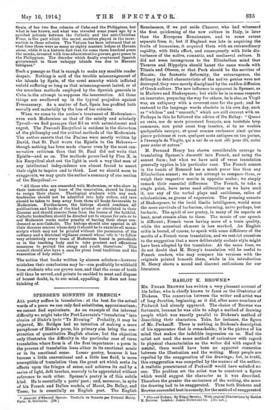HABLOT K. BROWNE.•
Ma. EIXidE BROWNS has written a very pleasant account of his father, who is chiefly known to fame as the illustrator of Dickens. The connexion between the writer and artist was of long duration, beginning, as it did, after some numbers of Pickwick had already appeared. The choice of Browne was -fortunate, because he was able to adopt a method of drawing people which was exactly parallel to Dickens's method of describing their characters. Take, for instance, the figure of Mr. Pecksniff. There is nothing in Dickens's description of his appearance that is remarkable; it is the picture of his mind that makes the indelible impression on us. Had the artist not used the same method of caricature with regard to physical characteristics as the writer did with regard to mental, there would have been no apparent connexion between the Illustration and the writing. Many people are repelled by the exaggeration of the drawings; but, in truth', this exaggeration was compelled by the manner of the author. A realistic presentment of Pecksniff would have satisfied no one. The problem set the artist was to construct a. figure which would suggest the character as it was described. Therefore the greater the caricature of the writing, the more the drawing had to be exaggerated. Thus both Dickens and Browne succeeded beet in comedy, for the method of exaggerated • pm, and Bass.; By Edgar Browne. With Original Thastittionn 'by Riddell K. Browne. London: James Nisbet and Co. [15s. ust.3, emphasis does not accord with sentiment. We delight in Pecksuiff, Micawber, Qui1p, Mrs. Getup, and all their fellows ; but no amount of sentimental heightening will make us believe in, or care for, Little Nell and her grandfather, either as described or drawn.
Mr. Browne gives us a delightful picture of family life in the "fifties," with its amusements. A description of Albert Smith's famous entertainment, with its moving scenery, shows us how difficult it is even for ardent reformers to make an advance, and reminds us that Parsifal is in one respect early Victorian. Very amusing, too, is the author's account of Jullien, that strange popular orchestral conductor, whose immense white waistcoat was by no means the least of the attractions of his concerts. But Jullien, in spite of his absurdities, so amusingly described by Berlioz, did something towards the popularization of Beethoven's symphonies. Mr. Browne gives us a characteristic glimpse of the man, who after the effort of conducting his military quadrilles sank exhausted into a golden chair—of course before the audience.
A number of reproductions of drawings and water-colours have been included in the volume, and these show Hablot Browne in very different styles. There is no question, how- ever, that be was at his best in the strongly emphasized character studies, such as the Dickens illustrations. But it is curious to see how the artist seems to have been attracted by abstract beauty, although he failed to realize it, and his efforts in this direction are without distinction. Only one example of serious portraiture is given—a chalk drawing of Arthur Hill. This work shows not only a grip of character, but a power of construction and modelling that is masterly.











































 Previous page
Previous page